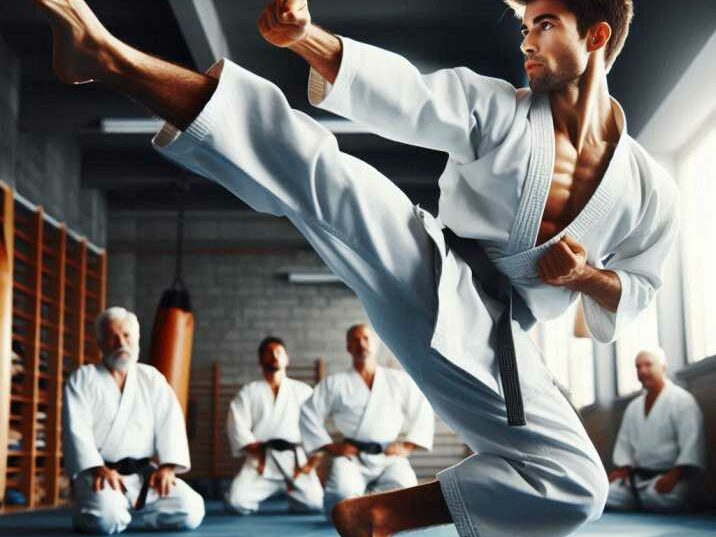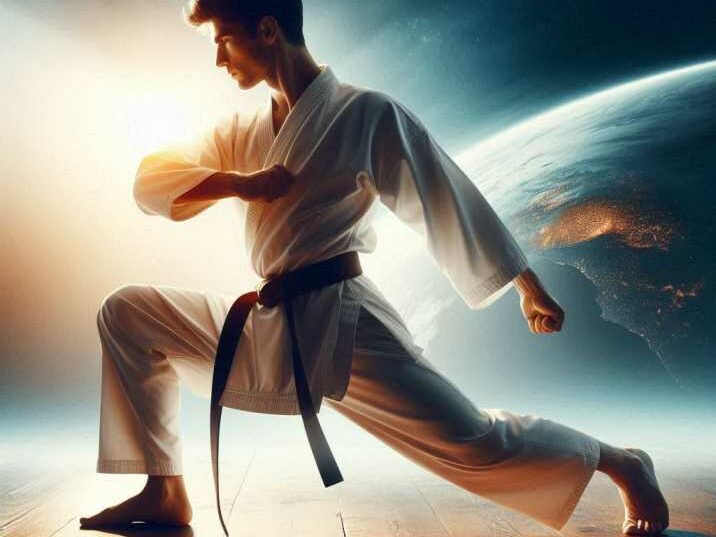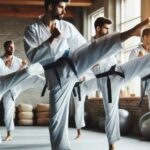Introduction
Table of Contents
Karate is a popular fighting style known around the world for its high kicks, fast punches, and disciplined techniques. But have you ever wondered why some people say it’s inaccurate to call karate a martial art? In this article, we will explore this interesting idea, understand what makes karate unique, and see why the term “martial art” might not fit perfectly. Let’s embark on this journey to uncover the truth behind karate!

What is Karate?
Origin and Meaning
Karate’s Origin:
- Okinawa, Japan: Karate originated on the island of Okinawa, Japan, during the early 20th century. It developed from a mix of traditional Okinawan fighting techniques and Chinese martial arts that were introduced to Okinawa through trade and cultural exchanges.
- Historical Development: Over time, karate evolved into a distinct martial art with its own techniques, forms, and training methods. It was influenced by various martial arts practices and adapted to the local context of Okinawa.
Meaning of Karate:
- “Empty Hand”: The term “karate” is derived from the Japanese words kara (空) meaning “empty” and te (手) meaning “hand.” Thus, “karate” translates to “empty hand.” This refers to the practice of martial arts without the use of weapons. Instead, practitioners rely on their hands, feet, and body to defend themselves and strike opponents.
Techniques
Karate Techniques:
- Punches: Karate includes a variety of punching techniques, such as the oi-zuki (lunge punch) and gyaku-zuki (reverse punch). These punches are designed to deliver powerful and precise strikes to an opponent.
- Kicks: Karate features various kicking techniques, including the mae-geri (front kick), yoko-geri (side kick), and mawashi-geri (roundhouse kick). These kicks are used to attack an opponent from different angles.
- Blocks: Blocks are defensive techniques used to stop or deflect an opponent’s attacks. Common blocks include the age-uke (rising block) and gedan-barai (downward block), which help protect different areas of the body.
Focus on Physical Fitness and Mental Discipline
Physical Fitness:
- Strength and Conditioning: Karate training improves overall physical fitness by developing strength, endurance, and flexibility. Techniques and drills help build muscle and improve cardiovascular health.
- Coordination and Agility: Practicing karate enhances coordination and agility, as practitioners must execute techniques with precision and speed. This helps in developing quick reflexes and balance.
Mental Discipline:
- Self-Discipline: Karate emphasizes self-control and discipline. Practitioners are taught to manage their emotions, stay focused, and follow a structured training regimen.
- Respect and Etiquette: Karate fosters respect for oneself, instructors, and fellow practitioners. This respect is demonstrated through proper etiquette, such as bowing before and after training and showing humility.
- Personal Growth: The mental aspects of karate contribute to personal growth and development. Practitioners learn perseverance, patience, and the importance of continuous improvement.
The Term ‘Martial Art’
The term “martial art“ refers to various combat practices and techniques developed for self-defense, military training, or personal development. Martial arts are characterized by their emphasis on combat skills, discipline, and sometimes spiritual aspects.
Characteristics of Karate
Karate is known for its distinct features:
Techniques
Karate Techniques are the fundamental movements used to defend oneself and attack an opponent. These techniques include:
- Strikes: Karate features a variety of strikes such as punches (known as tsuki), which involve hitting with the fist, and kicks (known as geri), where practitioners use their legs to strike. Common types of kicks include the front kick, side kick, and roundhouse kick.
- Blocks: These are defensive moves used to stop or deflect an opponent’s attacks. For example, a gedan-barai is a downward block used to protect the lower body.
- Parries: Similar to blocks, parries involve redirecting an opponent’s strikes away from the body, often with a sweeping motion.
Each technique is designed to be precise and effective, with an emphasis on speed, power, and accuracy.

Forms (Kata)
Kata are pre-arranged sequences of movements practiced in karate. They serve multiple purposes:
- Practice Techniques: Kata allows practitioners to rehearse and perfect their strikes, blocks, and movements in a structured manner.
- Developing Rhythm and Flow: By practicing kata, karateka (karate practitioners) learn how to move fluidly and transition smoothly between techniques.
- Mental Discipline: Performing kata requires concentration and mental focus, helping to improve a practitioner’s discipline and mental strength.
Each kata has a specific name and purpose, and they are often performed solo. Kata are also used in competitions to showcase a practitioner’s technique and precision.
Philosophy
The Philosophy of karate is a crucial aspect of its practice and includes:
- Self-Discipline: Karate emphasizes the importance of controlling one’s actions and emotions, both in and out of the dojo (training hall). Practitioners learn to push their limits and stay focused on their goals.
- Respect: Respect for oneself, one’s instructor, and fellow practitioners is a fundamental principle in karate. This respect is demonstrated through proper etiquette, such as bowing before and after training sessions.
- Personal Growth: Karate aims to develop more than just physical skills. It encourages practitioners to grow mentally and emotionally, fostering qualities like perseverance, humility, and integrity.
Sport
Karate as a Sport involves competitive events where practitioners showcase their skills in both forms and sparring:
- Forms Competitions: In these events, participants perform katas and are judged on their accuracy, technique, and presentation. Points are awarded based on how well the kata is performed.
- Sparring (Kumite): Sparring is a competitive match where practitioners use karate techniques against an opponent in a controlled setting. Points are awarded for successful strikes, and matches are won based on skill and technique.
Karate as a sport is not only about fighting but also about demonstrating precision, discipline, and respect in a competitive environment.
Historical Context
Karate’s history is a blend of different influences. It was influenced by traditional Chinese martial arts and developed in Okinawa during the early 20th century. Over time, it gained popularity and spread worldwide, becoming a major martial art practice.
Karate vs. Martial Arts
While karate shares similarities with other martial arts, it also has unique characteristics:
Origin
Karate’s Origin:
- Okinawan Roots: Karate originated in Okinawa, an island in Japan. Its development was influenced by traditional Chinese martial arts that were introduced to Okinawa through trade and cultural exchanges. The unique blend of these influences led to the creation of karate as a distinct martial art.
- Cultural Context: The history of karate is deeply connected to Okinawan culture and its history of resistance and self-defense. It evolved from indigenous fighting methods and was shaped by the socio-political environment of Okinawa during the early 20th century.
Comparison with Other Martial Arts:
- Chinese Martial Arts: Many martial arts, such as Kung Fu, originated in China. These arts often emphasize a wide range of techniques including strikes, kicks, and forms, and have deep roots in Chinese philosophy and traditional medicine.
- Korean Martial Arts: Martial arts like Taekwondo and Hwa Rang Do come from Korea. Taekwondo, in particular, is known for its high, fast kicks and is influenced by Korean culture and military traditions.
- Japanese Martial Arts: Arts such as Judo and Aikido originated in Japan. Judo focuses on throws and grappling, while Aikido emphasizes joint locks and throws with a philosophy of harmony and redirecting force.
Technique Focus
Karate’s Technique Focus:
- Strikes and Kicks: Karate is renowned for its emphasis on powerful strikes and precise kicks. Techniques include various types of punches (like tsuki) and kicks (such as mae-geri or front kick). The focus is on delivering effective, direct attacks.
- Forms (Kata): Karate uses forms or kata to practice techniques and movements. These are choreographed sequences that help practitioners develop precision and consistency in their techniques.
Comparison with Other Martial Arts:
- Judo: Judo’s primary focus is on throws, pins, and joint locks. It does not emphasize striking techniques. Instead, it teaches practitioners how to use an opponent’s force against them, with a strong emphasis on grappling and balance.
- Taekwondo: While Taekwondo also includes strikes, it is especially known for its high, fast kicks. The art places a significant emphasis on kicking techniques and agility.
- Boxing: Boxing, another combat sport, focuses predominantly on punching techniques. Unlike karate, boxing does not include kicks or blocking techniques and has a distinct style of footwork and defense.
Practice
Karate’s Practice:
- Forms (Kata): Karate practice includes performing kata, which are pre-arranged sequences of movements. Kata are designed to help practitioners internalize techniques and develop a rhythm in their movements.
- Sparring (Kumite): In karate, sparring involves practicing techniques in a controlled environment against an opponent. It helps practitioners apply techniques learned in kata in a dynamic and interactive way.
Comparison with Other Martial Arts:
- Judo Practice: Judo practitioners spend considerable time learning throws, joint locks, and ground techniques through drills and randori (free practice). The focus is more on grappling and less on forms or kata.
- Taekwondo Practice: Taekwondo training involves practicing high kicks, forms (also known as poomsae), and sparring. The practice often includes a strong emphasis on flexibility and speed.
- Aikido Practice: Aikido practitioners focus on blending with the attacker’s movements and using their own momentum against them. Training involves a lot of partner drills and less emphasis on traditional forms.
Table of Information
| Heading | Details |
|---|---|
| What is Karate? | Definition and history of karate. |
| The Term ‘Martial Art’ | What does it mean to be a martial art? |
| Characteristics of Karate | Key features of karate that distinguish it from martial arts. |
| Historical Context | The historical development of karate. |
| Karate vs. Martial Arts | Comparing karate with other traditional martial arts. |
| FAQs | Frequently asked questions about karate and martial arts. |
Conclusion
In conclusion, karate is a fascinating practice with a rich history and unique characteristics. While some might argue that it doesn’t fit perfectly into the category of martial arts, it is essential to understand that karate shares many traits with traditional martial arts, including discipline, combat skills, and personal growth. Whether you call it a martial art or not, karate remains a valuable practice for those seeking physical and mental development.
FAQs
- Is karate a martial art?
- Karate is indeed considered a martial art, though its specific characteristics may not fit every definition of martial arts.
- Why might some say karate isn’t a martial art?
- Some believe karate’s focus on strikes and forms makes it different from martial arts that emphasize grappling or self-defense.
- What is the main purpose of karate?
- The primary purpose of karate is to develop physical fitness, mental discipline, and self-defense skills.
- How does karate differ from taekwondo?
- Karate and taekwondo are both martial arts, but taekwondo emphasizes high, fast kicks, while karate focuses more on hand techniques.
- Can karate be used in self-defense?
- Yes, karate techniques are effective for self-defense, including strikes and defensive moves.


